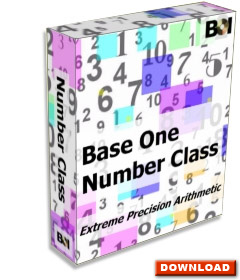Base One Number Class, v. 7.5
Fix the loopholes in C++ high-precision arithmetic
Featured in: Essential Software Library,
From: Content Galaxy Inc.
Fast, high-precision decimal arithmetic for C++
The Base One Number Class is an innovative technology for performing extremely precise mathematical
calculations. If you are a programmer building applications for a large financial institution,
an engineer designing a high-precision telemetry system, or a scientist striving to minimize
errors in the analysis of experimental data, you will immediately recognize the value of the Number Class. Even in less demanding applications you may be surprised to discover how
often undetected computational errors lead to significant inaccuracies, which are readily eliminated
by using the Number Class. (U.S. Patent Number 6,384,748)
To
subscribe and download
Base One Number Class, click on box

You get the full source code and can build applications that support an unlimited number of users.
-
Full ANSI/C++ source code, with extensive comments and documentation
-
Source is Windows, Unix, and 64-bit ready
-
Support for Windows 7, 2008, 2003, XP
-
STL (Standard Template Library) and MFC (Microsoft Foundation Classes) support
-
Thorough online documentation and examples
Why Use the Base One Number Class?
Base One's Number Class is a general-purpose alternative to the built-in numeric data types of C++, with
added safeguards against a variety of common (and not-so-common) errors. Whether you write programs for
Windows, Linux, Unix, DOS, or any other platform, you can use our Number Class just as easily as the native C++
number types. If you have an existing application, conversion couldn't be easier. With a few localized
changes to include our header files, huge applications can be made to support greatly enhanced precision
simply by recompiling.
Comprehensive error handling
Even if your application doesn't require the highest level of precision, Base
One's Number Class makes it easier to write reliable applications by adding
convenient error-trapping features. This covers errors like Overflow, Divide by
zero, Invalid sign, etc., which are not handled automatically by C++.
C++ provides only minimal facilities for detecting and handling errors that
can occur in numeric arithmetic and conversion operations. This makes it
necessary for programmers to take extra steps to be sure that certain errors,
such as division by zero and overflow, can not occur. Otherwise, a program may
crash or simply yield incorrect results when one of these exceptional conditions
arises.
All too often obscure bugs result from failing to add adequate error checking
logic. The Number Class provides additional capabilities for detecting and
handling errors, so these details don't burden the programmer but they also
don't get overlooked.
Division by zero
C++ also doesn't detect invalid attempts to divide a number by zero (unless
you consider immediately crashing to be a form of error "detection").
This too is a type of error that the Number Class makes easy to trap and handle
cleanly, again without a lot of extra code. The Number Class also detects
attempts to raise 0 to a negative power.
Conversion errors
Another important category of errors is those that can occur when converting
back and forth between different types of numeric and character representations.
The limited error-handling features of C++'s conversion functions are greatly
improved upon in the Base One Number Class. For example, Number Class conversions
discriminate among many specific error types, such as invalid sign, missing
digit, negative number converted to an unsigned data type, particular flavors of
overflow, etc. You also have the choice of detecting errors either based on a
return code or by raising an exception for which you can supply your own
handler.
Bottom line: you are guaranteed to be warned if the number is too large to be
stored or if a desired degree of accuracy (precision) can't be maintained. Using
the Number Class prevents the silent destructiveness of overflow, which comes with
all the C++ numeric data types.
But the main point is that numbers can be large - with many digits both to the
left and to the right of the decimal point. Support for larger ranges of
values avoids insidious arithmetic truncation, without any special effort
dedicated to overflow error detection and handling.
To learn more about the Base One Number Class: